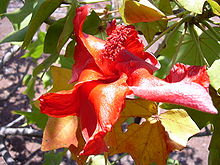- Kokia cookei
-
Kokia cookei 
Conservation status Scientific classification Kingdom: Plantae (unranked): Angiosperms (unranked): Eudicots (unranked): Rosids Order: Malvales Family: Malvaceae Genus: Kokia Species: K. cookei Binomial name Kokia cookei
O.Deg.[2]Kokia cookei is a small, deciduous tree commonly known as the kokiʻo, Molokaʻi treecotton, Cooke's kokiʻo, or Molokaʻi kokiʻo. It is considered one of the rarest[3] and most endangered plant species in the world. Even when first found in the 1860s, only three trees could be located.[4] It was presumed extinct in the 1950s when the last surviving seedling perished. However, in 1970, a single plant was discovered on the same Kauluwai estate where the "last" individual grew, presumably a surviving relict of one of the plants previously cultivated there. Although this tree was destroyed in a fire in 1978, a branch that was removed earlier was grafted onto the related, and also endangered, Kokia kauaiensis. Currently there exist about 23 grafted plants.[3]
It is only known to have existed in the lowlands of western Molokaʻi in the Hawaiian Islands. Presumably, its native habitat was lowland dry forests on the leeward western end of the island; this was all but cut down by Polynesian settlers about the year 1000 AD to make room for agriculture. It seems to have been noted by these settlers, as suggested by the native name hau heleʻula ("entirely red hau").[5] The three trees initially found grew near Mahana, northeast of Puu Nana[3] at approximately 200 metres (660 ft) elevation.[3]
Although the original forest ecosystem was destroyed and replaced by shrubland with plants like native ʻilieʻe (Plumbago zeylanica) and introduced flora, Molokaʻi kokiʻo survived initially. It seems to have had some tolerance to habitat change, enabling it to hang on until the 19th century.
Contents
Putative pollinators
Its eventual extinction in wild state of the species seems for a large part due to coextinction with native nectarivorous birds. K. cookei seems to be adapted to bird pollination like most related Malvaceae. The birds, Drepanidinae, were extirpated from dryland forest by Polynesians, and most remaining species entirely succumbed to mosquito-borne diseases like avian malaria (Plasmodium relictum) and fowlpox in the 19th century.
The wide, large flowers of Molokaʻi kokiʻo would have admitted a wide range of potential pollinators (as opposed to e.g. Hibiscadelphus):
- Maui Nui ʻAlauahio, Paroreomyza montana ssp? - extirpated from island (prehistorically?)
- Kākāwahie, Paroreomyza flammea - extirpated from lowlands by 1900, extinct (1963)
- Common ʻAmakihi, Hemignathus virens - extirpated from lowlands by 1900
- ʻIʻiwi, Vestiaria coccinea - extirpated from lowlands by 1900
- Black Mamo, Drepanis funerea - extinct (1907); not certain if it regularly occurred in habitat
- ʻApapane, Himatione sanguinea - extirpated from lowlands by 1900
- ʻAkohekohe, Palmeria dolei - extirpated from island (1907); not certain if it regularly occurred in habitat
(after James & Olson 1991, Olson & James 1991)
Of these, the ʻIʻiwi was perhaps the most important, given that the other species are/were all either smallish and short-billed (K. cookei has quite large flowers), or did probably not occur in its habitat in significant numbers.
Notes
- ^ World Conservation Monitoring Centre (1998). Kokia cookei. 2006. IUCN Red List of Threatened Species. IUCN 2006. www.iucnredlist.org. Retrieved on 22 April 2007.
- ^ "Taxon: Kokia cookei O. Deg.". Germplasm Resources Information Network. United States Department of Agriculture. 2004-04-20. http://www.ars-grin.gov/cgi-bin/npgs/html/taxon.pl?320100. Retrieved 2011=02-21.
- ^ a b c d USFWS (1998): Recovery Plan for Kokia cookei. U.S. Fish and Wildlife Service, Portland, OR.
- ^ USFWS. K. cookei Five-year Review. January 2008.
- ^ Kokia cookei. Center for Plant Conservation (CPC) (2002). Retrieved 21 April 2011.
References
- Olson, Storrs L. & James, Helen F. (1991): Descriptions of thirty-two new species of birds from the Hawaiian Islands: Part I. Non-Passeriformes. Ornithological Monographs 46: 1-91.
- James, Helen F. & Olson, Storrs L. (1991): Descriptions of thirty-two new species of birds from the Hawaiian Islands: Part II. Passeriformes. Ornithological Monographs 46: 1-92.
- Marinelli, Janet (2005): Plant. DK, New York. ISBN 075660589X
External links
Categories:- IUCN Red List extinct in the wild species
- Kokia
- Plants described in 1934
- Endemic flora of Hawaii
Wikimedia Foundation. 2010.

